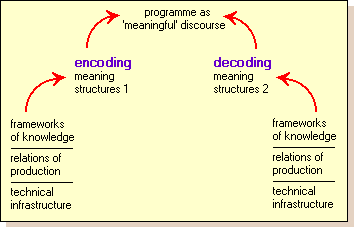 This post will define and place in historical context two media research theories: the “magic bullet” (“hypodermic”) model and the encoding/decoding model. It will then compare the theories in terms of their treatment of the audience and their relationship to power structures.
This post will define and place in historical context two media research theories: the “magic bullet” (“hypodermic”) model and the encoding/decoding model. It will then compare the theories in terms of their treatment of the audience and their relationship to power structures. The earliest media research occurred in the 1920s and reflected the insecurities and paranoias of the time. In response to the pessimistic “mass society thesis” of the Frankfurt School, early researchers believed communication worked by injecting powerful messages into the minds of passive audiences. Theorists saw how both sides in the First World War used propaganda to such great effect that it acquired “a reputation of omnipotence”. The evolution of propaganda in radio and cinema encouraged Laswell and others to view mass media as having a powerful influence on public opinion. According to this notion, the media fired off “magic bullets” which merely had to hit their target to produce the desired effect. The theory was also called the “hypodermic model” which imagined the media as syringes able to “inject” narcotic propaganda directly into the veins of the audience. But by the 1940s and 1950s, researchers were beginning to rebuff the “pessimistic” thesis saying it proposed too powerful and unmediated an impact by the media. They began to look at the active role of the audience in the making of meaning.
By the 1970s, alternative ideas were taking shape which placed communication in a wider socio-cultural context. Stuart Hall’s ‘encoding/decoding’ model emerged out of a British semiotic and cultural studies approach to media studies. Semiotics is a textual analysis of how meaning is created in language, non verbal codes and cultural “signs”. Audiences were no longer “empty vessels” to pour meaning into, they were considered culturally formed and situated. Hall called the phases of his model “moments” which he defined in Marxist terms as “production, circulation, distribution /consumption, reproduction”. Each “moment” played a role in the manufacture of meaning. Audiences could accept, negotiate, or reject the media texts they were presented with. Researchers now had a model to show what audiences did with media as opposed to what media did with audience.
A key difference, therefore, between the hypodermic and encoding/decoding models is how they view the role of the audience. Effects theorists believed that audiences were passive and culture could be imposed from above by an elite group of skilled manipulators. While the hypodermic theory has a psychological plausibility, it fails to take into account that communication is not just about sending messages, it is about the sharing of meaning. Hall’s model offers better insights into the way culture operates by demonstrating how various actors change communication at each step in the process. The model emphasises the discourse rather than the participants and examines how each of the “passage of forms” in the process flow provide meaning to the message. Encoding/decoding encouraged research to move away from media effects towards audience talk and increased focus on communities, particularly marginalised ones. Yet although the hypodermic theory is now academically discredited, it continues to have resonance in the wider community especially in the context of violent media effects on children. It also underpins the one-dimensional nature of the media’s own ratings measurement research.
 The hypodermic and encoding/decoding models are also subtly different in their treatment of power structures. The simplistic linear Shannon-Weaver model of communication which fits the earlier theory is superseded by Hall’s more complex diagram of frameworks producing meaning which are mediated by the discursive elements of the broadcast programme. Whereas the earlier theory proposed a simplistic but all powerful media, the encoding/decoding model suggested a sophisticated hegemony existed which operated through popular culture. Hall demonstrated how the “professional codes” of the media integrate with the cultural and social order to become a bulwark of the power structure. Hall showed that power in communication is more likely to be transmitted by signification than by syringe.
The hypodermic and encoding/decoding models are also subtly different in their treatment of power structures. The simplistic linear Shannon-Weaver model of communication which fits the earlier theory is superseded by Hall’s more complex diagram of frameworks producing meaning which are mediated by the discursive elements of the broadcast programme. Whereas the earlier theory proposed a simplistic but all powerful media, the encoding/decoding model suggested a sophisticated hegemony existed which operated through popular culture. Hall demonstrated how the “professional codes” of the media integrate with the cultural and social order to become a bulwark of the power structure. Hall showed that power in communication is more likely to be transmitted by signification than by syringe.
1 comment:
Hey that was so straight forward! I just did about two arduous hours of readings on encoding/decoding and could not make sense of any of it- and you managed to explain it in 5 short paragraphs! Thanks! :D
Post a Comment